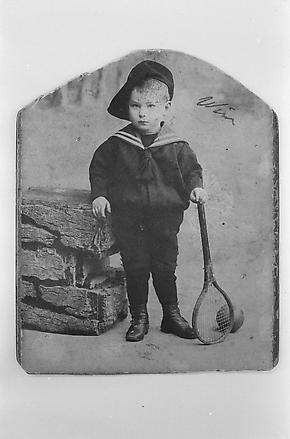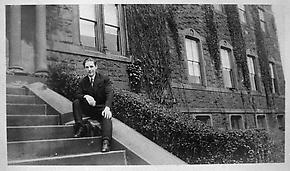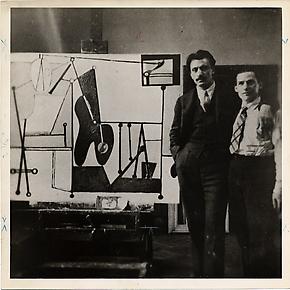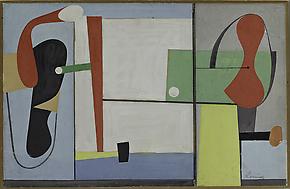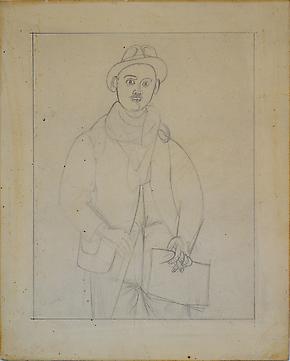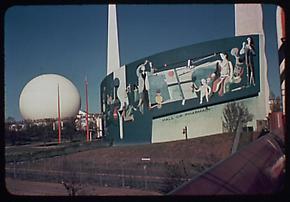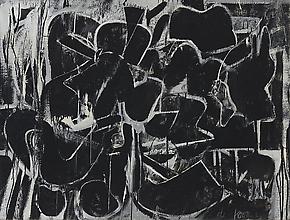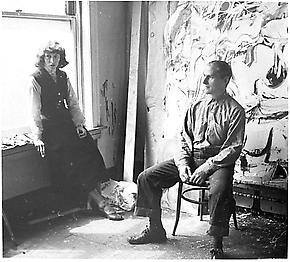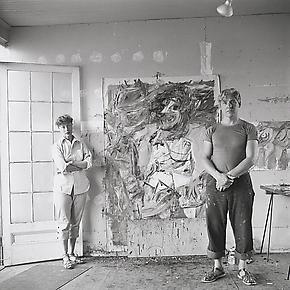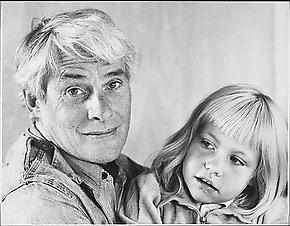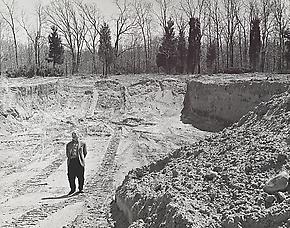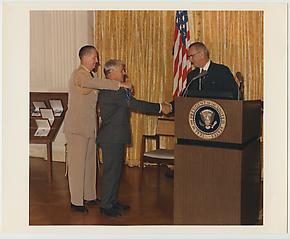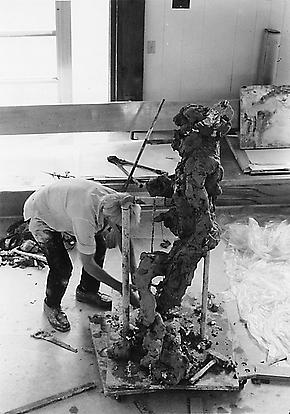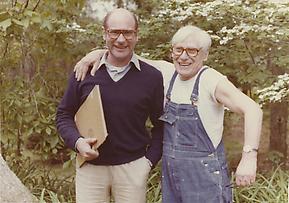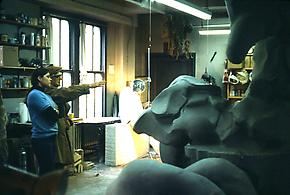1904
April 24. Born in Rotterdam, the Netherlands.
1916
Left grammar school; began apprenticeship with the commercial art and decorating firm of Jan and Jaap Gidding, Gidding & Zonen.
1917-21
Attended night classes at the Rotterdam Academy of Fine Arts and Techniques, studying drawing and the applied arts; possibly returned to continue his studies in 1925.
1920
Left Gidding & Zonen to work for Bernard Romein, art director and designer for Rotterdam department store, Cohn Donnay & Co.
1924
Traveled to Belgium with friends; worked briefly for the Van Genechten decorating firm in Brussels.
1926
July 18. Sailed as a stowaway, entering the United States illegally on July 30th in Newport News, Virginia; settled temporarily in Hoboken, New Jersey. Worked as a house painter.
1927
Moved to New York City; worked for Eastman Brothers, a design and decorative firm.
1929-31
Met John Graham, Stuart Davis, David Smith, Sidney Janis and Arshile Gorky, who became one of his closest friends.
1935
Left his job designing display windows for A.S. Beck, a shoe-store chain, which he held since 1929 or 1930, to join the WPA Federal Art Project.
c. 1935-37
After August. Joined mural division of WPA Federal Art Project; worked on murals for Williamsburg Federal Housing Project in Brooklyn and for the French Line Pier Project in New York with Fernand Léger (neither were executed). Left WPA after less than two years because he was not a U.S. citizen and, after the passage of the “Alien Rule,” feared he might be found out. This work experience provided him impetus to concentrate his energies on painting full time.
1936
September 14 – October 16. Included in first museum exhibition, “New Horizons in American Art,” The Museum of Modern Art, New York.
c. 1936
Met critic Harold Rosenberg, who became an important supporter of his work.
1938
Commissioned to design one section of three-part mural Medicine, for 1939 New York World’s Fair, Hall of Pharmacy.
Met art student Elaine Fried, who briefly became his student.
1939-40
Met Franz Kline, who became one of his closest friends.
1942
Met Jackson Pollock.
January 20 – February 6. Included in his first gallery exhibition, “American and French Paintings,” McMillen Gallery, New York, organized by John Graham; resulted in his first mention in the press.
1943
December 9. Married Elaine Fried.
1948
April 12 – May 12. First one-man exhibition, “de Kooning,” Charles Egan Gallery, New York (held over through June); resulted in his first New York press review, written by Renée Arb in ARTnews, and a favorable review by Clement Greenberg in The Nation.
Met critic Thomas Hess.
July 1 – August 25. Taught at Black Mountain College, North Carolina at invitation of Josef Albers.
July 21. Arshile Gorky committed suicide.
October. First museum purchase, Painting, 1948, by The Museum of Modern Art, New York.
1949
February 18. Delivery of his first public lecture/paper, “A Desperate View,” at the Subjects of the Artist School, New York, possibly by Robert Motherwell.
Joined newly organized artists’ discussion group, “The Club,” 39 East 8th Street (East Village), New York (as charter member).
Early 1950s
Drank alcohol to manage anxiety and heart palpitations at the suggestion of artist and scientist, Alfred L. Copley (Alcopley). Progressively drank more heavily by mid-1950s, with periodic binging that continued through the 1970s.
1950
Completed Excavation, subsequently exhibited at XXV Venice Biennale, June 3 – October 15.
Began work on Woman I.
1951
Received Logan Medal and Purchase Prize from the Art Institute of Chicago for Excavation (1950), resulting in the museum’s purchase of the painting.
c. 1951-52
Began spending summers in East Hampton, New York.
1953
March. Publication of “De Kooning Paints a Picture” by Thomas B. Hess in ARTnews, chronicling the creation of Woman I (1950 – 1952).
March 16 – April 11. First one-man exhibition at Sidney Janis Gallery, New York (his new gallery), “Paintings on the Theme of the Woman”; included Woman I (1950 – 1952), purchased by The Museum of Modern Art in June.
April 21 – May 8. First retrospective exhibition, “de Kooning: 1935 – 1953,” School of the Museum of Fine Arts, Boston (traveled to Workshop Art Center, Washington, D.C.).
Robert Rauschenberg requested and received a drawing from de Kooning to erase, now known as Erased de Kooning Drawing (1953).
1956
January 29. Daughter Johanna Liesbeth (Lisa) born to Joan Ward.
August 11. Jackson Pollock died in car crash.
1957
Made his earliest surviving print, Revenge, an etching for Harold Rosenberg’s poem, for inclusion in portfolio 21 Etchings and Poems, 1960.
1958
Declined The Museum of Modern Art’s invitation to have major retrospective exhibition of his work.
1959
Publication of his first monograph, Willem de Kooning by Thomas B. Hess.
1959-60
September 1959 – January 1960. Traveled to Italy. In Rome, at Afro Basaldella’s studio, painted experimental black-and-white works on paper known as the “Romes.” Met Alberto Burri and Cy Twombly.
1960
Traveled to San Francisco where he made his first two lithographs.
1961
Began to design and build studio in Springs, New York.
1962
March 13. Became U.S. citizen.
May 13. Franz Kline died.
1963
March. Moved permanently to Springs from New York City.
1964
September 14. Awarded The Presidential Medal of Freedom by President Lyndon B. Johnson.
1965
April 8 – May 2. First American museum retrospective, “Willem de Kooning,” Smith College Museum of Art, Northampton, Massachusetts (traveled to The Hayden Gallery, Massachusetts Institute of Technology, Cambridge).
1966
Signed exclusive contract with dealer M. Knoedler & Co., where Xavier Fourcade represented him.
1968-69
September. Returned to the Netherlands for first time since 1926 for opening of his first international retrospective exhibition, “Willem de Kooning,” at the Stedelijk Museum, Amsterdam (September 19 – November 17), organized by Thomas B. Hess (traveled to The Museum of Modern Art, New York; The Tate Gallery, London; The Art Institute of Chicago; Los Angeles County Museum of Art).
1969
July. Traveled to Spoleto and Rome. Stayed in Spoleto as an invited guest of the Festival of Two Worlds XII, where his exhibition “de Kooning: Drawings” was shown from June 28 to July 13. In Rome, modeled first 13 sculptures in clay at the foundry of sculptor and friend, Herzl Emanuel, who cast and editioned them in bronze.
1970
January 16. Traveled to Japan with Xavier Fourcade, visiting Tokyo, Kyoto and Osaka, where he spent time with Isamu Noguchi.
1970-71
Created a series of lithographs at Hollander Workshop, New York.
1970-74
Produced a body of sculpture in clay with assistant David Christian, cast at Modern Art Foundry, Queens, New York.
1975
October 25 – December 6. First one-man exhibition at Fourcade, Droll Inc., New York, “De Kooning: New Works – Paintings and Sculpture.” Xavier Fourcade, Inc. succeeded Fourcade, Droll in 1976 and represented de Kooning exclusively until Xavier Fourcade’s death in April 1987.
1978
July. Harold Rosenberg and Thomas Hess died.
1978-80
Resumed daily contact with Elaine de Kooning, who assisted him in regaining health after dangerous bouts with alcoholism. Studio practice re-structured and new assistants hired.
1979
April 24. On his 75th birthday, was named an Officer of the Order of Orange-Nassau by the Dutch government.
1980
Started process of enlarging three of his 1969 bronzes to mid- and monumental-size with Bruce Hoheb, to be cast at Tallix Foundry, Peekskill, New York.
1982
March 17 – May 1. First exhibition to focus on works from the 1980s, “Willem de Kooning: New Paintings, 1981 – 1982,” Xavier Fourcade, Inc., New York.
1983-84
December 15, 1983 – February 26, 1984. Major retrospective exhibition, “Willem de Kooning: Drawings, Paintings, Sculpture,” Whitney Museum of American Art, New York (traveled to Academie der Künste, Berlin; Musée National d’Art Moderne, Centre Georges Pompidou, Paris).
1984
Commissioned by St. Peter’s Lutheran Church, New York, to paint triptych for its altar. In 1985, it was installed but subsequently rejected as too personal a form of art for group worship.
1989
February 1. Elaine de Kooning died.
11 February. As he appeared to be suffering from Alzheimer’s-like dementia and could no longer manage his business affairs, his daughter, Lisa de Kooning, and John L. Eastman petitioned the New York Supreme Court to be appointed conservators of the property of Willem de Kooning. The petition was granted on September 27th.
1991
Stopped work on his last painting.
1993-95
October 21, 1993 – January 9, 1994. First comprehensive exhibition of largest public collection of his works, “Willem de Kooning from the Hirshhorn Museum Collection,” Hirshhorn Museum and Sculpture Garden, Washington, D.C. (traveled to Fundació "la Caixa," Barcelona; High Museum of Art, Atlanta; Museum of Fine Arts, Boston; Museum of Fine Arts, Houston).
1994-95
May 8 – September 5. Paintings retrospective, "Willem de Kooning: Paintings," National Gallery of Art, Washington, D.C. (traveled to Metropolitan Museum of Art, New York; Tate Gallery, London).
1995-97
October 3, 1995 – January 7, 1996. First museum overview of works from the 1980s, “Willem de Kooning: The Late Paintings, The 1980s,” San Francisco Museum of Modern Art (traveled to Walker Art Center, Minneapolis; Städtisches Kunstmuseum, Bonn; Museum Boymans-van Beuningen, Rotterdam; Museum of Modern Art, New York).
1997
March 19. Died at the age of 92, at his home in East Hampton, New York.
Compiled by
Compiled by The Willem de Kooning Foundation, as of January 9, 2014. Major published sources: Diane Waldman, “Chronology,” Willem de Kooning (New York: Abrams, Inc., 1988); Judith Zilczer, “Chronology,” Willem de Kooning from the Hirshhorn Museum Collection (Washington, D.C.: Hirshhorn Museum and Sculpture Garden, 1993); Mark Stevens and Annalyn Swan, de Kooning: An American Master (New York: Alfred A. Knopf, 2004); Delphine Huisinga, “Chronology,” de Kooning: A Retrospective (New York: The Museum of Modern Art, 2011).
